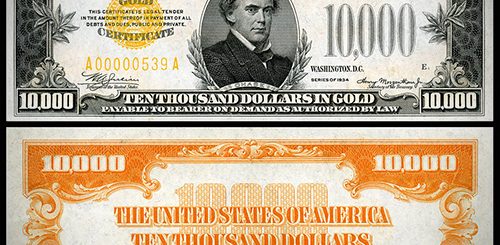Series of 1882 $100 Large Gold Certificate Review

The Series of 1882 $100 Large Gold Certificate is one of the most diverse historical notes when it comes to the range in values. Depending on the variety and condition of the bill, it may be appraised at three, four, five and even six figures, meaning certain types are greatly coveted by collectors.
History
Gold certificates were widely used during the American Gold Standard, which lasted from the 1860s until the Great Depression of the 1930s. Although the certificates themselves were a type of paper money, they had the backing of gold and thus were redeemable for gold coins. This meant that every note authorized holders to a corresponding amount. However, President Roosevelt made gold illegal to own during the 1930s (which including these certificates) yet many owners refused to sell it and thus kept it in storage. Today the bill can no longer be redeemed for gold directly but is popular for its intrinsic value.
Currency Characteristics
Those who own or are considering buying this note should analyze it carefully. Every bill has Thomas Hart Benton on the front, who was a Congressman between 1821 and 1855. He was a Missouri Democrat who played a key role in western expansion and Manifest Destiny, and was the first Senator who served 5 terms. He supported the annexation of Texas, which was achieved successfully by 1845, and has also given his support to the Oregon Treaty.
In addition to being honored by being placed on the 1882 $100 Gold Certificate, in seven states various counties were named in his honor. The back of the bill displays a prominent orange with an eagle in the center. The term “gold certificate” meant that the original owner of the bill had physical gold held in a vault that the bill could be redeemed for, which was common in American currency that was issued between 1863 and 1933. The banks of the time could issue these certificate notes for gold that was unallocated or allocated.
Given that the $100 1882 certificate was issued in fifteen varieties, some are relatively common while others are exceptionally rare. The most valuable are those in Uncirculated or About Uncirculated condition. The notes will usually have a Burke/Teehee signature and are distinctive for the vivid white coloration in the paper. Collectors look for bills that have few or no folds and creases, high quality red and gold ink and margins which are a bit uneven.
Collection Value
Generally speaking, all variants of this bill are rare, so when they appear at minimum they will usually sell for about three figures. But there are about three hundred fifty notes that are rarer than usual and as such carry a much higher collection value that average. In fact, one 1882 $100 bill from the New Mexico Territory, called a “brownback” was appraised at about $75,000. Other bills which are sought after are those which have a blue seal.


